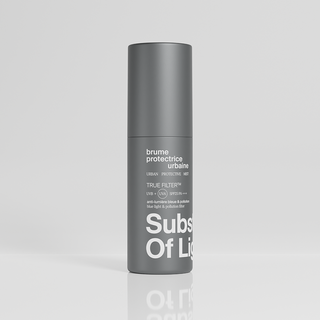Introduction
Every day, our skin is exposed to environmental aggressions. Among these factors, UV radiation, which includes UVA, UVB, UVC, stands out by degrading skin texture, wrinkles, hyperpigmentation , and even increasing the risk of skin cancer .
Do you know the differences between UVA, UVB, and UVC rays? What are their relevance and what are their impacts on the skin? How should we approach them on a daily basis to better protect our skin? Deciphering the nuances between UVA, UVB, and UVC rays, and their impact on skin health.
The three types of UV radiation
Invisible electromagnetic spectrum:
UV radiation, invisible to the naked eye, requires a thorough understanding. Visible sunlight and invisible UV rays differ, with the latter penetrating even through clouds . Energy is measured by wavelength in nanometers, where longer wavelengths mean lower energy.
UVA: the rays of aging
Depth and long-term impact:
UVA rays, ranging from 320 to 400 nm, penetrate deep into the skin, even through clouds and windows. Responsible for long-term skin aging (causing pigment spots, wrinkles, and sagging skin), they create toxic reactive species that damage lipids, proteins, and DNA. With daily exposure 100 times higher than UVB rays, indoor protection remains essential.
UVB: burning rays
Immediate and long-term damage:
At a higher frequency (290-320 nm), UVB rays cause immediately visible sun damage, such as sunburn ( solar erythema). Their closer link to DNA damage makes them the leading cause of skin cancer . Better UVA-UVB protection is crucial to prevent these consequences.
UVC: rays blocked by ozone
Energetic but blocked:
Although UVC is the most energetic (200-290 nm), most is blocked by the ozone layer, limiting its impact on the skin.
HEV: High Energy Visible or Blue Light
Visible blue light : an invisible enemy for the skin
Blue-violet light , emitted by the sun and digital screens, poses a threat to skin health. With a wavelength of 400 to 500 nm, it accelerates cellular aging, causing wrinkles and spots. About 25% of cellular damage is attributed to this light. It can penetrate even deeper than UVA rays and synergistically penetrate the skin layers, exacerbating aging.
Conclusion: Protect your skin daily
Sun protection tips:
To prevent damage, opt for a broad-spectrum sunscreen that protects against UVA, UVB, and HEV rays. Apply daily and be sure to use at least 1/4 teaspoon for optimal protection.
Essential reminder:
Sunscreen isn't like your favorite concealer. Results may not be immediately visible, but damage, such as photoaging, hyperpigmentation, and cancer risk, is measured over the long term. Daily sun protection is crucial from a young age to maintain the health of your skin and prevent photoaging and skin cancer. Skin care is an essential component of overall health.
TRUE FILTER Urban Protective Mist: the ultimate protection against UVA, UVB, and HEV (blue light)
TRUE FILTER™ provides complete broad-spectrum protection against UVA, UVB, and blue light (HEV), outperforming conventional sunscreens. With SPF25, this mist filters out 96% of UVB rays, emphasizing UVA, the main contributor to photoaging. With a PA+++ rating, it effectively targets photoaging, reducing skin aging by up to 80%. In addition, it protects against blue light (HEV) and pollution, outperforming "broad-spectrum" or PA-rated products. TRUE FILTER™ removes nearly 90% of Reactive Oxygen Species (ROS), from pollution and visible light, providing a robust defense against skin aging.
Explore Substance Of Light® TRUE FILTER™ Urban Protective Mist, a true breakthrough in everyday skin protection.

Bibliography
- https://hal.science/hal-01869698v1/html_references
- R. Rox ANDERSON, BS AND JOHN A. PARRISH MD (1981)https://www.sciencedirect.com/science/article/pii/S0022202X21011234
- Amaris N. Geisler BS a, Evan Austin BS bc, Julie Nguyen MD bc, Iltefat Hamzavi MD d, Jared Jagdeo MD, MS bc, Henry W. Lim MD “Visible light. Part II: Photoprotection against visible and ultraviolet light” https://www.sciencedirect.com/science/article/abs/pii/S0190962221004084
- D'Orazio, John. “UV Radiation and the Skin.” National Institutes of Health, National Institutes of Health, June 20, 2023, https://www.ncbi.nlm.nih.gov/pmc/articles/PMC3709783/
- World Health Organization https://www.who.int/news-room/questions-and-answers/item/radiation-ultraviolet-(uv)
- IARC Working Group in 1992 , https://monographs.iarc.who.int/wp-content/uploads/2018/06/mono100D-6.pdf
- J, L. “The Effects of UVA-I (340-400 Nm), UVA-II (320-340 Nm) and UVA-I+II on the Photoisomerization of Urocanic Acid in Vivo - PubMed.” National Institutes of Health, National Institutes of Health, https://pubmed.ncbi.nlm.nih.gov/9337619/












